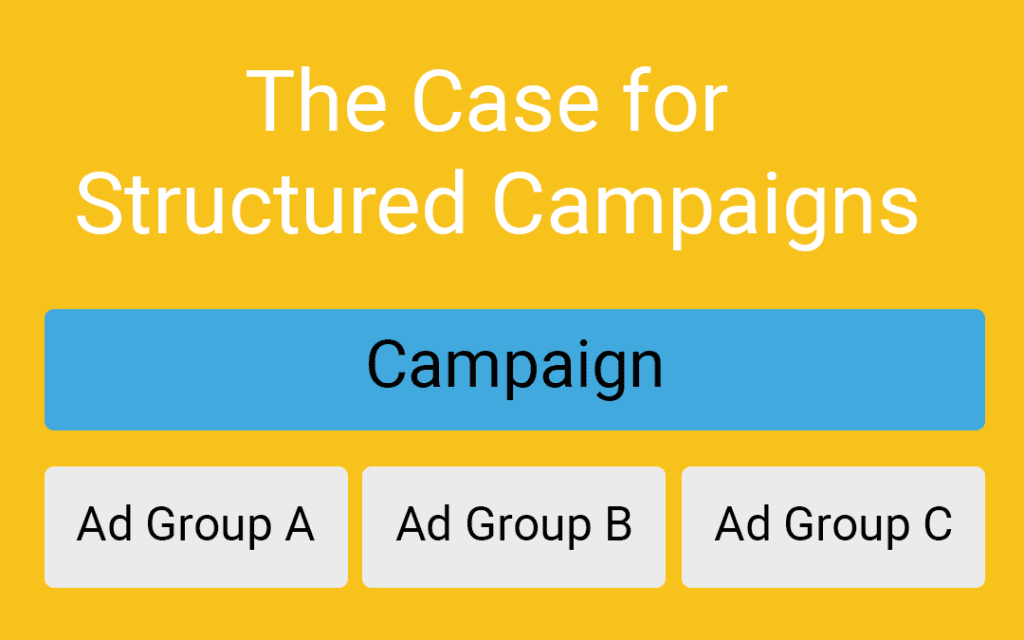Most digital marketing platforms offer a variety of ways to organize your campaigns along with a reporting hierarchy that follows the organizational structure for those campaigns closely.
Google Ads, for example, is organized around the hierarchy of campaigns > ad groups > keywords.
| Campaign | |||||
| Ad Group A | Ad Group B | Ad Group C | |||
| Keyword 1 | Creative 1 | Keyword 1 | Creative 1 | Keyword 1 | Creative 1 |
| Keyword 2 | Creative 2 | Keyword 2 | Creative 2 | Keyword 2 | Creative 2 |
As expected, Google Ads native reporting structure follows the account structure. You can report on campaigns, ad groups, keywords, creative, and various other elements, such as ad extensions.
Let’s jump over to Campaign Manager. Campaign Manager has a different structure that reflects its focus on display advertising: Campaign > Placement > Ad > Creative
| Campaign | |||||
| Placement A | Placement B | Placement C | |||
| Ad 1 | Ad 2 | Ad 1 | Ad 2 | Ad 1 | Ad 2 |
| Creative 1 | Creative 1 | Creative 1 | Creative 1 | Creative 1 | Creative 1 |
Again, Campaign Manager’s native reporting largely follows the campaign architecture along with a number of other available reporting dimensions.
The inherent reporting capabilities of the platforms are great when you are working within each platform individually, but what happens when you want to start exporting data from these platforms and fuel consolidated, multi-channel reporting via cloud or on-premise database and visualization tools? It quickly becomes apparent that each platform has internal consistency and rich reporting structure, but frequently lacks consistently with many other platforms due to the inherent differences between different kinds of advertising.
So, how can you give yourself the advantage of a common format for rich campaign data across all of your channels and tactics? Structured campaign naming is one effective way to do it.
Advantages of Structured Campaign Names
Structured campaign names are not new and they aren’t really all that complicated. Like so many things in digital marketing, the success or failure at implementing structured campaign names ultimately boils down to two crucial factors: people and processes. As a Marketing Director or CMO, if you want to make changes to your data capture, you really do have to make it mandatory and comprehensive across your marketing teams. Consistency is crucial for this tracking upgrade to be useful, so having buy-in and compliance from your various campaign managers and campaign coordinators is key. I’ll go out on a limb and say that data quality management should be part of your team’s OKRs. This makes them accountable for campaign tracking being:
- Consistent
- Comprehensive
- Correct
Strive for 90% or better for each of those criteria.
Back to structured campaign names:
What is a more meaningful campaign naming structure in the examples below:
Campaign Name 1: christmas-2019
Camapign Name 2: Display | Remarketing | High Value Customers | US | National | Spring Collection 2019 | 20 Off
Example one is sort of structured in that it includes two dimensions in a single campaign name:
promotional time period (Christmas) and year (2019).
The second example is a strong example of what we mean by a structured campaign name. Here we have truly rich detail about the campaign:
- Channel (display)
- Tactic (remarketing)
- Target Audience (high-value customers)
- Geo-Targeting (US)
- Geo-Targeting Level 2 (national)
- Campaign (spring collection 2019)
- Offer (20% off)>/li>
This second example provides six distinct dimensions within a single attribute: campaign name. Because each dimension is delimited with a common character (vertical pipe in this case), an analyst or data viz specialist can easily parse this campaign name into its component dimensions for use in consolidated reporting and dashboards.
Since every platform you use is going to have the shared attribute of campaign name, this is a great way to introduce not only rich campaign naming across your organization but also the ever-elusive consistency.
Implementing Structured Campaign Names
Take some time with your marketing team to decide which campaign attributes are most important to your reporting and dashboards. Keep in mind that not every attribute will apply to every campaign in every channel. Simply account for adding in values for when a particular element in general, not applicable, or undefined. Every campaign name should have either a value or a placeholder for ‘undefined’ for each element of the structured campaign name.
Create a spreadsheet-based tool shared across your marketing team so that you can build consistency into the process by which you tag your campaigns.
For elements that have a fixed number of valid values, you can lock down the tool to give your marketers the ability to choose from a dropdown list of approved options.
Alternately, there are now specialized tools like Claravine, CampaignTrackly, Taglynx, and others that make applying governance to this process easier across larger organizations.
Create a checklist to ensure that campaigns do not go live until someone has validated that the required tagging is in place and meets the tracking needs of your organization,
Happy rich-campaign-analyzing!














